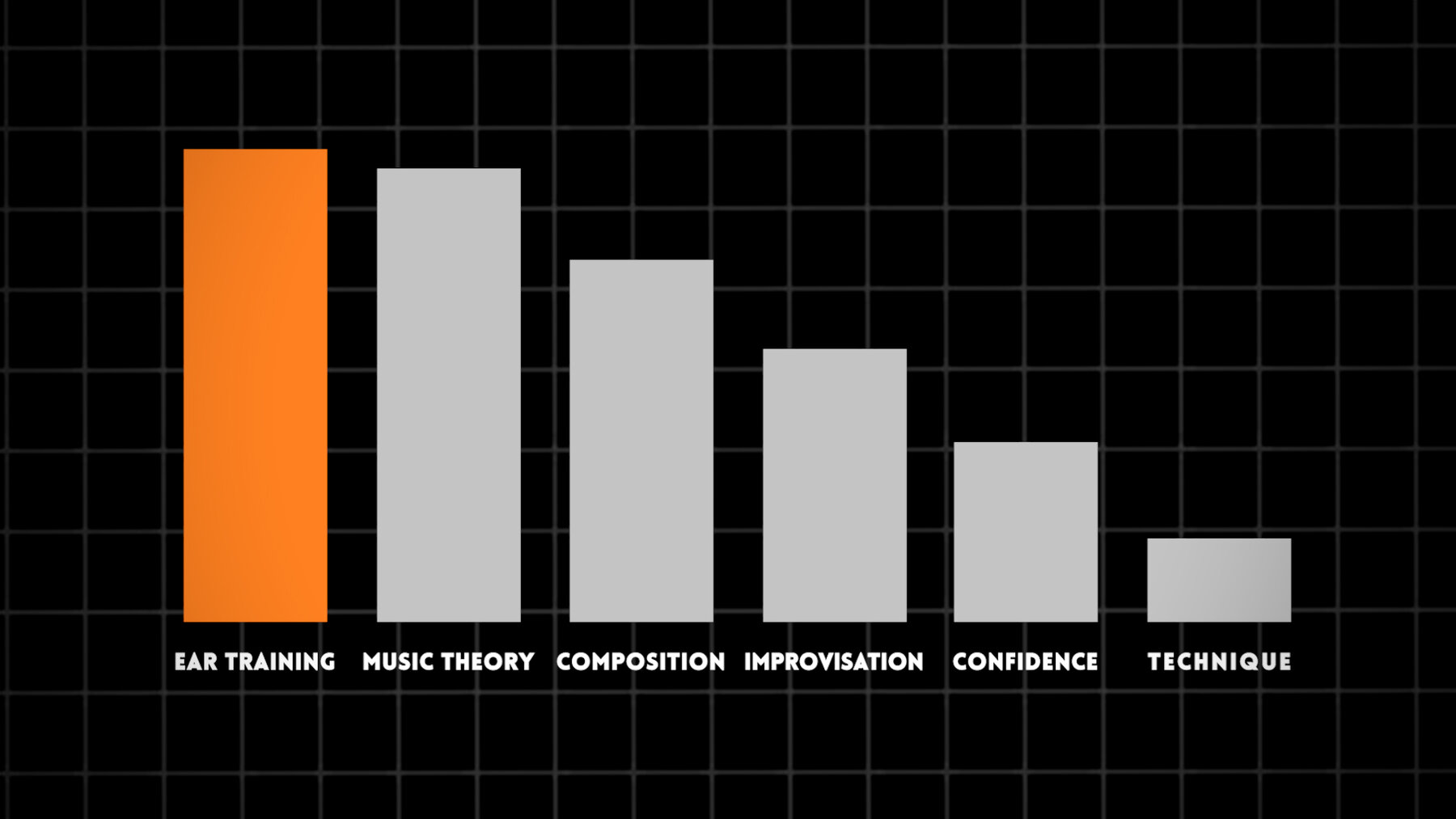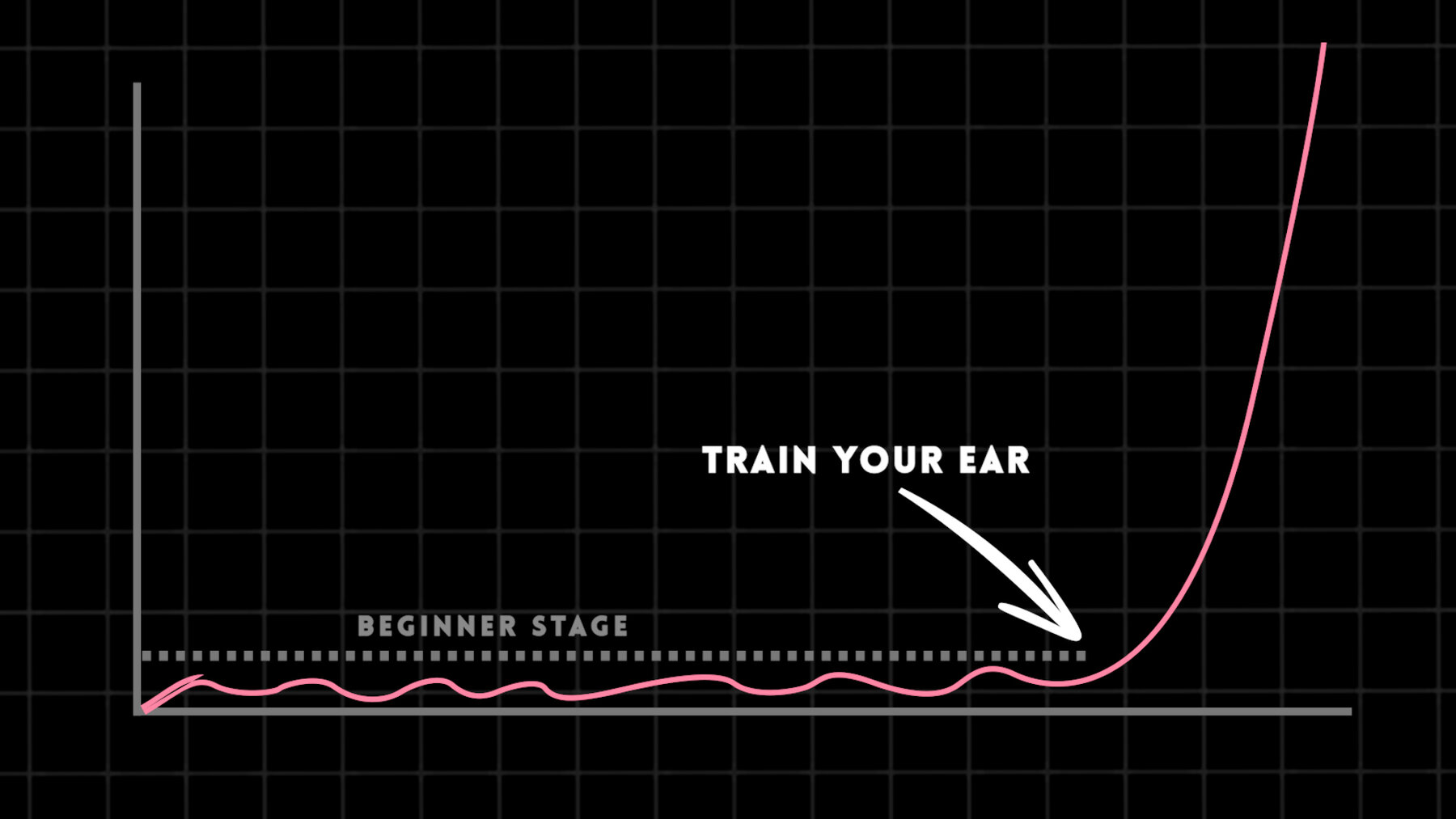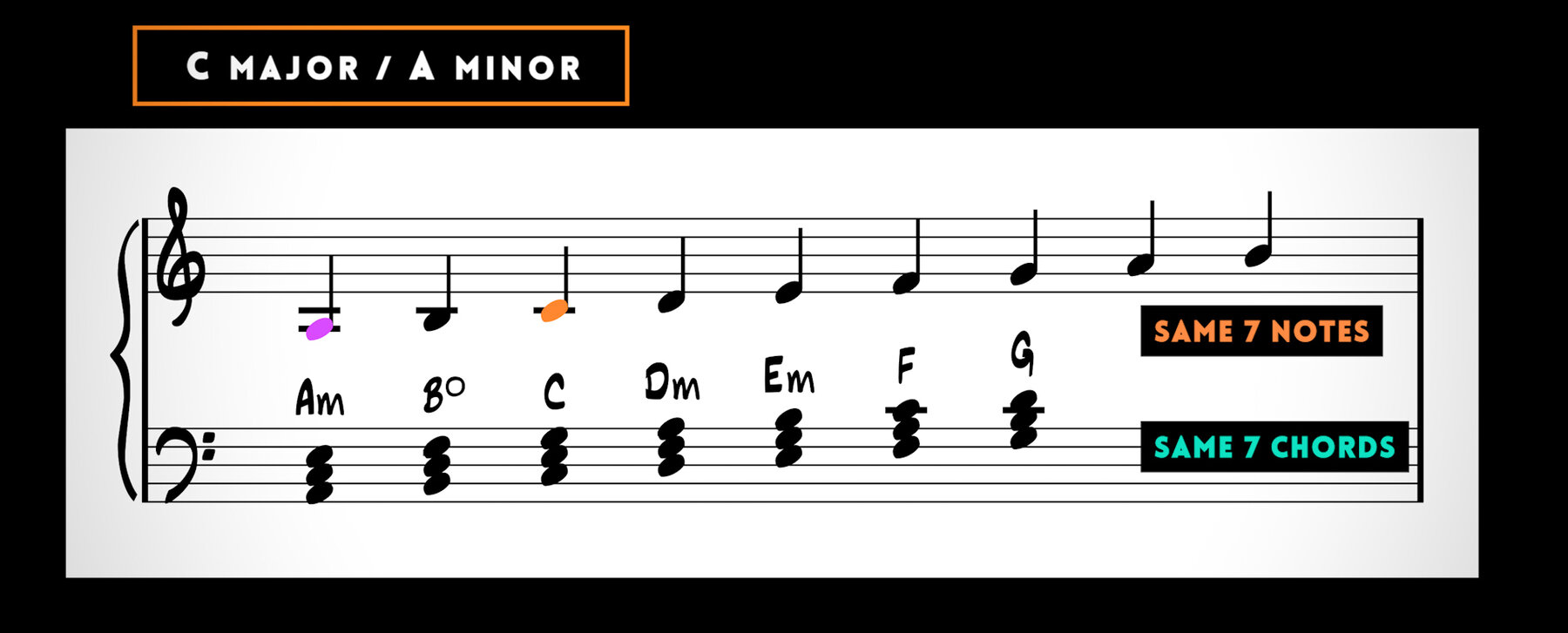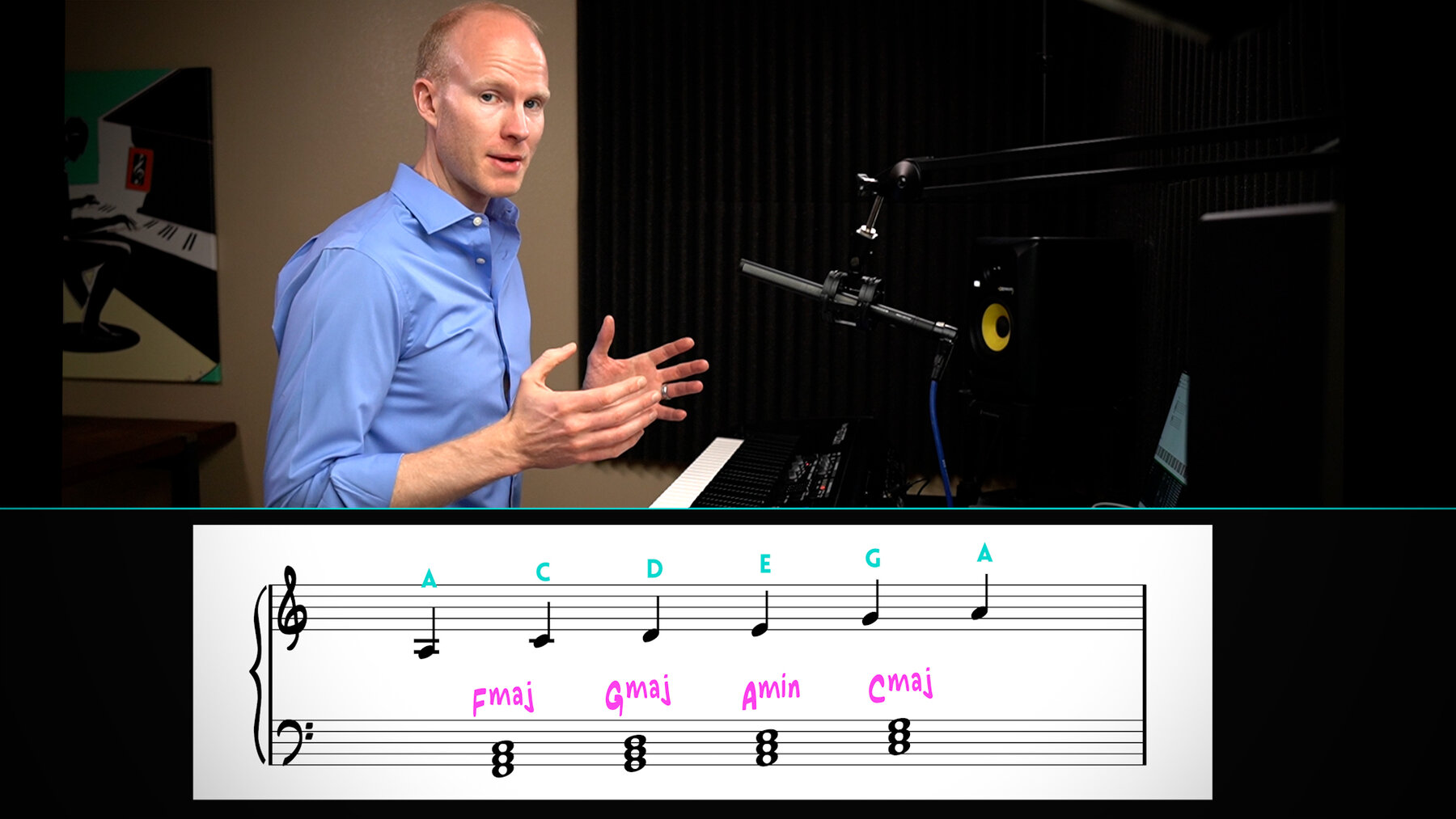The 2 Paths to Learn Music
The #1 musical skill of all time
When you look at the great musicians, they've always had one skill in common:
They could all play music by ear.
Think of Beethoven, Mozart, Prince, Duke Ellington, Pharrell Williams, Timbaland, The Beatles, Sting, John Williams, Glenn Miller, or Miles Davis...
They all had this skill - without exception.
All skills are tied to your ear
Until you train your ear, there's an invisible barrier limiting you in everything you do.
But when you practice ear training, everything else follows naturally:

-
You compose better music.
-
You write music faster.
-
Your knowledge of music theory shoots up.
-
Your CONFIDENCE increases.
-
Even your technique improves - to keep up with all of your musical ideas.
Everyone can learn to play by ear
The good news is that every musician can learn this skill (anyone with hearing).
You can learn relative pitch at any age, in as little as six months.
Especially if you've been playing music for a few years already.

In fact playing music by ear is less to do with your ear than most people think...
It's more to do with learning music theory, so that you know how music works and what to expect.
Learn ear training in one key
The Musical Ear is my complete video course that teaches you how to play music by ear - from the ground up.
The whole course is taught in one key (the key of C major / A minor):

I've packed together the highlights of a 4-year music degree, and boiled it down into a series of step by step videos.
The lessons walk you through YEARS of rigorous music education in just a few hours.
Ear training made simple
I've tried to make ear training as simple for you as possible:
-
Everything is taught in one key (that makes things 12 times simpler).
-
I teach you at the piano, so you can see everything (melody and chords).
-
All lessons are pre-recorded videos (so you can watch them anytime, no live trainings you have to show up for).
-
You get the lessons to keep - so you can re-watch as many times as you need.
Practical Exercises
In addition to the lessons, I provide you with ear training 'practice runs'.
These are pre-recorded videos where I test you on real songs (just like an ear training lab at college).

Listen to them as many times as you need, and take them with you 'on the go' (they can be listened to as audio, or with video).
"Who's it for?"
This course is for musicians who never had formal training at a music college.
If you have any regrets about not attending music college, this course is designed for you.
It provides you with the highlights of a 4-year college degree boiled down - so you quickly fill in any gaps to your theory knowledge.
Testimonials
Posting Schedule
When you join today you'll get instant access to the first 15 lessons (3 hours of video).

Goind forward you'll receive each of the remaining lessons and practice sessions as I post them (by email).
When the course is complete, you will have lifetime access to the finished course.
Introductory Price
Since the course is still being produced, you can join today at an introductory price:
Join today for just one payment of $299 USD.
Or you can choose the payment plan, which is 3 monthly payments of $120 USD.
Going forward, you will receive all future course updates I post, for no extra charge.
120-Day Money Back Guarantee
As always, you have my money-back guarantee.
If for any reason this training is not right for you - I will fully refund your purchase.

120 days should be enough time for me to post the remaining Musical Ear lessons and practice sessions.
Get Started Today
Enrollment to The Musical Ear is open for a limited time.
To join today, just choose from the two payment options below, and I will see you in lesson 1 in just a moment:

Pay in Full
-
Instant access to the first 15 lessons
-
All upcoming videos emailed to you
-
Lifetime access to finished course
-
120-day guarantee
$399 value
Just $299 USD today

Payment Plan
-
Instant access to the first 15 lessons
-
All upcoming videos emailed to you
-
Lifetime access to finished course
-
120-day guarantee
3 monthly payments of $120
Course Outline
The Musical Ear gives you 3 hours of concise step-by-step video lessons:
-
Part 1. 'The Terrain of Music'. First we memorize the key: major and relative minor scales, primary chords, the pentatonic scale degrees, resolution and tension notes, which chords exist within the key, interval locations, and how melody and chords go together. First we memorize this terrain that music is written in.
-
Part 2. Transcribing Melody (Techniques). Next we study the 6 intervals you need to know to play by ear (not 12), how to learn intervals by ear, 'pillar notes' within the scale, note resolutions, how to locate an interval's location within the scale, the pentatonic shape, and how to transcribe a melody.
-
Part 3. Transcribing Chord Progressions (Techniques). Why most chords that exist will never be used, the 6 chords that make up 95% of songs (memorize these). The 4 pop chords. How bass lines work. Resolution chords and tension chords, how to guess the most logical chords by 'thinking as the composer', and the melody / chord relationship.
-
Part 4. Common Patterns in Music. I'll show you the most popular melodic shapes and chord progressions of all time - all lined up in one key for clarity. When you know what these common shapes are - transcribing them is virtually effortless - you'll just know what the notes are because you've heard them hundreds of times.
-
Part 5. Transcribing Complete Songs (melody, chords, bass line). Now that we've covered music theory in depth, you're ready to transcribe songs by ear. I'll walk you through 12 ear training video sessions at the piano to show you the process.
-
12 Ear Training Practice Sessions. Join me at the piano for a series of listening exercises, and put your theory knowledge to the test. I'll guide you through the transcribing process until it becomes a habit.
-
Bonus | How to play in all 12 keys. So far the whole course has been taught in the same key (C major / A minor). To end, I'm going to show you how to transpose everything from the one key into all the other keys.
"Who is this course for?"
If you experience any of the following, I made this course for you:
-
"I lack confidence in music and there's missing gaps in my theory training"
-
"I’ve hit a plateau and I’m playing the same things as 12 months ago."
-
"I rely entirely on sheet music and feel like I’m nothing without it."
-
"I don’t know how a note will sound until I play it."
-
"Music composition takes me a long time and most pieces don’t get finished."
-
"I struggle to find the notes in my imagination, and I often loose the tune in the struggle."
-
"I lack confidence because I never had ‘formal training’ in music."
If you feel any of the above, this course has been made for you.
Prerequisites
-
For all instruments, but must have basic piano skills.
-
3+ years piano experience (even if piano is not your main instrument).
-
Adult musicians only (18+). Not for young children. College style teaching.
-
Reading music is NOT necessary (although I do display some sheet music in some lessons).
This is my most accessabile course. It delivers solid music theory training while being accessible to beginners.
"What does the course come with?"
- 14 video lessons (3 hours of music theory training).
- 10 transcribing sessions (ear training practice videos).
- Lesson notes (download and print these).
- Recommended songs for transcribing.
Get Started Today
Enrollment to The Musical Ear is open for a limited time.
To join today, just choose from the two payment options below, and I will see you in lesson 1 in just a moment:

Pay in Full
-
Instant access to the first 15 lessons
-
All upcoming videos emailed to you
-
Lifetime access to finished course
-
120-day money back guarantee
$399 value
Just $299 USD today

Payment Plan
-
Instant access to the first 15 lessons
-
All upcoming videos emailed to you
-
Lifetime access to finished course
-
120-day money back guarantee
3 monthly payments of $120
Hear what students are saying
These are some of the messages I received from students of The Musical Ear course.
What you will discover
-
Why music is not just major or minor anymore. Discover the ‘swaying effect’ and how modern music works (most music colleges never teach you this).
-
The 2 intervals you need to learn to transcribe 80% of melodies.
-
The 6 chords that make up 95% of chord progressions (there's not 24 major and minor chords that you have to transcribe).
-
The melody-chord relationship. When you know what the melody note is, you can guess the chord. And vice versa. Melody note and chord are always related.
-
How to think logically - and figuring out the most likely option without even using your ear.
-
My top 7 most common melodic shapes (when you know that these are, transcribing them is effortless. You just know what the notes are, because you've heard it a hundred times).
-
Common chord progressions (when you know what they are, you can’t miss them. Transcribing doesn’t even take effort).
-
Discover the 4 most common bass notes (most bass lines use these notes).
-
Resolution and Tension Notes, explained. Discover how notes want to resolve, and apply this knowledge to every scale.
-
The 3-step process for transcribing songs by ear (do this away from your instrument).
-
How to play in all 12 keys. At the end of the course, I show you how to transpose everything out into all 12 keys. When you do this the right way, you won't be intimidated playing in any key.
Course Q+A
"Does this course teach relative pitch or perfect pitch?"
The Musical Ear teaches you relative pitch - which is what I have (it's virtually unheard of to learn perfect pitch after age 10, and very few musicians have perfect pitch).
Relative pitch is just as valuable as perfect pitch and can be learned at any age. There are even some advantages to having relative pitch - like being able to listen to all music as though it's in the same key. Someone with perfect pitch can't switch off from knowing what the notes are.
"Will I be able to play 100% of music by ear after watching this course?"
The Musical Ear course teaches you how to play at least 95% of music - and will take you very far on your journey without overwhelming you with too much information.
"How is this course different to other ear training methods?"
There's two main differences:
First, The Musical Ear course focuses on music theory (playing by ear is 90% music theory, 10% ear training - yet most ear training apps never teach you music theory).
Second, The Musical Ear is taught entirely in one key (C major / A minor). By lining up all songs and teaching in one key, you'll quickly see how music works.
95% of songs use the same notes and chords as each other - the only thing changing is usually the key.
"Do I have to do all of my playing in one key?"
No. My 'fixed-key method' only applies to your ear training practice. You can continue playing the rest of your repertoire in other keys.
"How long should I play in one key?"
I recommend sticking to one key for life. There's no reason to change. I still listen to all music as though it's in the same key. If I need to play in a different key, I can transpose a song into any other key if I need to.
I consider 'transposition' to be a separate skill - and I end the course by teaching you this.
"Can I choose my own key?"
Yes. If you have a strong preference for a different key, you can transpose everything into your key. If you have no strong preference, I recommend using the key that I teach in which is A minor / C major.
Get Started Today
Enrollment to The Musical Ear is open for a limited time.
To join today, just choose from the two payment options below, and I will see you in lesson 1 in just a moment:

Pay in Full
-
Instant access to the first 15 lessons
-
All upcoming videos emailed to you
-
Lifetime access to finished course
-
120-day guarantee
$399 value
Just $299 USD today

Payment Plan
-
Instant access to the first 15 lessons
-
All upcoming videos emailed to you
-
Lifetime access to finished course
-
120-day guarantee
3 monthly payments of $120
Have a question?
